|
This is probably the most
vigorous workout of all. Before doing any lengthy and strenuous workout, ALWAYS ensure you have adequate fuel
stored. (such as loading up on
complex carbohydrates). If you dont have enough carbs to burn you can
almost guarantee (depending on your present bodyfat percentages) that you will
be burning your hard earned muscle. A potato or a carbohydrate mix will do just
fine.
|
 
Quads -
quadriceps - thigh - a four headed muscle group located on the front upper
leg, the quads basic function is to straighten the leg. These are the
largest and most powerful muscles of the entire body.
Hams
- hamstrings - made up of a number of muscles including the biceps femoris,
which, like the biceps of the arm, flex the lower leg on the upper leg (curl
the leg back).
Glutes
- gluetals - commonly used for sitting on. (they are generally involved in
movements which require the use of the quads). |
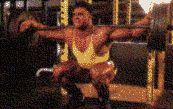 In the
opinion of most bodybuilders, the basic squat is the primary MASS BUILDER
for legs. There really is no secret to performing squats just precautions. When
doing squats ensure you are wearing a support belt no matter what the poundage
is. Doing extremely heavy weights with squats is not necessary nor is it
safe. A
maximum weight of 315 is plenty for doing basic squats considering the alternate
exercises that are available such as the hack squats and leg
presses It is very important to that you take care of your knees and back.
Try to make squats the first exercise in your leg routine. Perform 4 sets with 8
to 12 reps within each set. Use these to give your legs a good pump.
After a good pump is achieved try going to leg presses or hack squats to push
the HEAVY weight. These are much safe on the knees and back and does just
as well at building leg mass. In the
opinion of most bodybuilders, the basic squat is the primary MASS BUILDER
for legs. There really is no secret to performing squats just precautions. When
doing squats ensure you are wearing a support belt no matter what the poundage
is. Doing extremely heavy weights with squats is not necessary nor is it
safe. A
maximum weight of 315 is plenty for doing basic squats considering the alternate
exercises that are available such as the hack squats and leg
presses It is very important to that you take care of your knees and back.
Try to make squats the first exercise in your leg routine. Perform 4 sets with 8
to 12 reps within each set. Use these to give your legs a good pump.
After a good pump is achieved try going to leg presses or hack squats to push
the HEAVY weight. These are much safe on the knees and back and does just
as well at building leg mass.
|
 Leg presses
are excellent in building mass for the legs and provides a reasonably safe way
of doing it. Foot placement on this machine is very important. Depending on
where the feet are placed is what determines exactly which muscles in the legs
are doing most of the work. For instance, if the feet are placed farther apart,
the inner thighs (tear drop and up to groin area) are being worked more than the
outer. If legs are spaced closer together, the outer thigh is being worked more
than the inner. Another thing to consider about foot placement is whether or not
the foot is placed on the top, bottom, or middle of the platform. If the foot is
towards the bottom, more stress is placed on the knees and the calves are being
worked a little more. The best solution is to have the feet about 10 to 12
inches apart and placed from the center to the top of the platform. For better
leg development, leg presses should be done in HEAVY sets. Adjust the
weights so only 6 to 8 reps can be achieved, this focuses more on power and size. I recommend doing about 5 to 6 sets of these to really stimulate
growth.
After these are done, lets follow up on leg presses with a few sets of hack
squats. Leg presses
are excellent in building mass for the legs and provides a reasonably safe way
of doing it. Foot placement on this machine is very important. Depending on
where the feet are placed is what determines exactly which muscles in the legs
are doing most of the work. For instance, if the feet are placed farther apart,
the inner thighs (tear drop and up to groin area) are being worked more than the
outer. If legs are spaced closer together, the outer thigh is being worked more
than the inner. Another thing to consider about foot placement is whether or not
the foot is placed on the top, bottom, or middle of the platform. If the foot is
towards the bottom, more stress is placed on the knees and the calves are being
worked a little more. The best solution is to have the feet about 10 to 12
inches apart and placed from the center to the top of the platform. For better
leg development, leg presses should be done in HEAVY sets. Adjust the
weights so only 6 to 8 reps can be achieved, this focuses more on power and size. I recommend doing about 5 to 6 sets of these to really stimulate
growth.
After these are done, lets follow up on leg presses with a few sets of hack
squats.
|
 One good
thing about hack squats is that it is almost impossible to be out of form. If
you are uncomfortable with doing heavy weights with the basic squat, try it with
the hack squat. When doing these be sure to bend the knees to a full
bend, when
on the upward phase, rise far enough to where the legs are extended but the
knees are not locked. Foot placement on this exercise will have the same effects
on the muscle groups as in the leg presses. Try to have the feet 10 to 12 inches
apart so you can evenly work the quads. This is a great exercise to do after
doing basic squats or leg presses. It should be done with slightly lighter
weight to give to give you that "final pump". You should concentrate on getting
higher reps (8-10) for 3 sets on these. In my opinon, this exercise can be
considered a mass builder but also used for definition. One good
thing about hack squats is that it is almost impossible to be out of form. If
you are uncomfortable with doing heavy weights with the basic squat, try it with
the hack squat. When doing these be sure to bend the knees to a full
bend, when
on the upward phase, rise far enough to where the legs are extended but the
knees are not locked. Foot placement on this exercise will have the same effects
on the muscle groups as in the leg presses. Try to have the feet 10 to 12 inches
apart so you can evenly work the quads. This is a great exercise to do after
doing basic squats or leg presses. It should be done with slightly lighter
weight to give to give you that "final pump". You should concentrate on getting
higher reps (8-10) for 3 sets on these. In my opinon, this exercise can be
considered a mass builder but also used for definition.
|
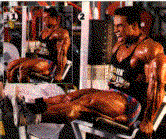 The leg extension can be used as a
warmup exercise or as another mass building exercise. Personally, I like to use
the leg extension as one of the final exercises (along with the leg curls) to
end my leg routine. Try to do 4 sets of these with the first two being heavy
sets (able to do up to 8 reps). Let the final 2 be your cool down sets. Try to
do a higher number of reps (10 to 12 reps). This provides for a good cool down
plus a period to work on definition. If you feel that you have exhausted the
quads before getting to this exercise, try doing all light weight sets to
work on definition. This also applies to the leg curls. Always remember that the
main thing you want to focus on is your form. You want to have a controlled
motion when lifting the weights and a resistence to them when lowering . If you
find yourself lacking control, decrease weight accordingly. The leg extension can be used as a
warmup exercise or as another mass building exercise. Personally, I like to use
the leg extension as one of the final exercises (along with the leg curls) to
end my leg routine. Try to do 4 sets of these with the first two being heavy
sets (able to do up to 8 reps). Let the final 2 be your cool down sets. Try to
do a higher number of reps (10 to 12 reps). This provides for a good cool down
plus a period to work on definition. If you feel that you have exhausted the
quads before getting to this exercise, try doing all light weight sets to
work on definition. This also applies to the leg curls. Always remember that the
main thing you want to focus on is your form. You want to have a controlled
motion when lifting the weights and a resistence to them when lowering . If you
find yourself lacking control, decrease weight accordingly.
|
|
 The
leg curl
is the reverse of the leg extension, While lying on the machine on your stomach,
lift the weights of the machine towards the rear end. This machine is used to
work the hamstrings. Doing extremely heavy weights with this machine can help
build the mass of the hamstrings but it is basically used for toning. This
machine can be used for a little of both. Try doing the first couple of sets
using heavier weight. Use weight heavy enough to get up to 6 reps. For the final
2 sets, try lowering the weight to maximize toning. Try to push out 10 to 12
reps. You may want to alter the weights and rep ratio for your personal needs.
If you want to focus more on definition, keep using lighter weights with more
reps. If your looking for mass, try heavier weights with less reps. But it is
best to do a little of both for better overall development. The
leg curl
is the reverse of the leg extension, While lying on the machine on your stomach,
lift the weights of the machine towards the rear end. This machine is used to
work the hamstrings. Doing extremely heavy weights with this machine can help
build the mass of the hamstrings but it is basically used for toning. This
machine can be used for a little of both. Try doing the first couple of sets
using heavier weight. Use weight heavy enough to get up to 6 reps. For the final
2 sets, try lowering the weight to maximize toning. Try to push out 10 to 12
reps. You may want to alter the weights and rep ratio for your personal needs.
If you want to focus more on definition, keep using lighter weights with more
reps. If your looking for mass, try heavier weights with less reps. But it is
best to do a little of both for better overall development.
I hope these techniques work as well for you as they have for me,
perfomed correctly, and in given time, you should see vast improvements in your
Quads.
|
 |
Sweat Those Legs!
Each set consists of eight repetitions.
To warm up: Do a set at fifty percent of your maximum effort. Begin with
three sets of eight. When you can't break a sweat with that, add five
more pounds - or do five more reps.
Squat.
Stand with your feet shoulder-width apart. Place a barbell across the
back of your shoulders. Squat down until your thighs are parallel to the
floor, then slowly raise up. |
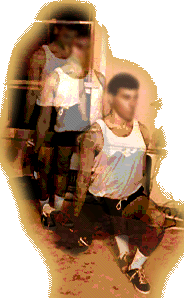 |
Lunge.
With a barbell across the back of your shoulders or while holding two
dumbbells, stand with your feet six inches apart. Take a large step
forward with your right foot, then bring your left knee down until it
almost touches the floor. Reverse the motion, stepping back to the
starting position. Note: The toes of your left leg shouldn't leave the
floor. Repeat with your other leg. |
 |
Leg
extension. Sit in a leg-extension machine with your feet
under the footpads. Lift the pads with your feet until your legs are
parallel to the floor. |
 |
Leg
Curl. Lie on your stomach with the backs of your heels
underneath the footpads. Curl the weight upward until your feet touch
your butt.
The one to do if you're doing only one? The squat.
|
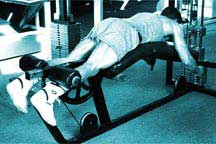

|
Leg
Curls
This
is the best exercise for isolating the hamstring muscle. I have called for
5 sets instead of 3 or 4 because there are very few ways to really isolate
this muscle. The good news is that there are many ways to vary the motion
and promote muscle confusion.
* Muscle Confusion Tips: There is usually more than one (?f'the.Ye
machines at the gym, try them all. Try Using a slight rocking motion to
life heavier weight than nor mal and return it slowly and very controlled
(negatives). Halfreps are an awesome variance to p romote muscle
concision. Try lowering the lever hal6vay, then back up far one set or
workout, then do the opposite (haway up) on your next set or
workout |
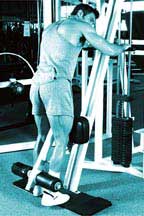

|
One
Leg Isolated Curls
This
movement is obviously very similar to that of the leg curl, except that
you can isolate even more by doing one leg at a time. The muscle confusion
tips are the same as with
* Muscle Confusion Tips: There is usually more than one qf these
machines at the gym, try them all. Try Using a slight rocking motion to li
.ft heavier weight than normal and return it slowly and very controlled (negatives). Half rep are also an awesome variance to promote muscie
confusion. Try bringing the lever down halfway then back up for one set or
workout, then do the opposite on your next set or workout. |


|
Stiff Legged Daet Lifts
Do
this slow and with good form as you gently stretch your hamstrings. As you
lower the bar slightly bend your knees and feel the stretch in the
hamstring area. Make sure you concentrate on keeping your back flat (don't
hunch over) to avoid injury. You may want to stand on a platform to
increase the range of motion. If you feel any lower back pain or excessive
hamstring pulling discontinue this exercise.
* Muscle Confusion Tips: There is not a lot that you can do to enhance
muscle confussion on this movement. Try doing higher reps, but not over 20
because fatigue may, lead to poor form and a possible injury. You can also
uve dumbbell which can extend the range of motion, but once again be
careful not to injure yoursel. |

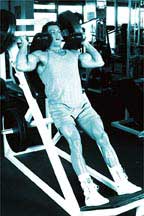
|
Hack
Squats
Perform hack squats as pictured in the
photo. Be careful not to go below parallel unless you are an experienced
lifter. Make sure to keep your posture as straight as possible. Hack
squats are an awesome exercise for overall leg development.
* Muscle Confusion Tips: Changing your
stance can have a profound effect on what area of the leg you train. If
you widen your stance and point your toes outward you will notice an
incredible burn in your inner thigh area. If you take a narrow stance
and slightly point your toes in, you will feel your outer thighs begins
to burn. Try placing your feet higher and lower on the platform to
create even more muscle confusion.
Leg Press
This movement is a classic leg developer.
It takes much of the pressure off the back and allows you to use fairly
heavy weights without injuring your back. You can also spot yourself by
placing your hands on your knees. Notice that the muscle confusion tips
are very similar to those of the hack squats.
* Muscle Confusion Tips: Changing your
foot position can have a profound effect on what area of the leg you
train. If you widen your feet and point your toes outward you will
notice an incredible burn in your inner thigh area. If you take an arrow
stance and very slightly point your toes in you will ,feel your outer
thighs begin to burn. Try placing your feet higher and lower on the
platform to create even more muscle confusion. You can spot yourself or
cheat by using your hands to push against your thighs
|
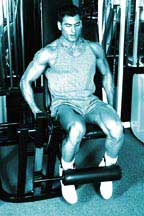

|
Leg Extensions
This is probably the best exercise to
isolate the quadriceps muscle. Try to pause for a half a second at the
top of the movement to really feel the muscle contract. As the photos
show, the muscle will be forced to contract and separate at the top of
the movement.
* Muscle Confusion Tips: Try pointing
your toes inward to feel your outer quads burn, or try pointing your
toes outward to feel your teardrop ail( I inner thighs burn. Half reps
are also a great variance on this movement. Try extending all the way up
and returning all the way down before starting to extend to the top
again. This is also a great movement for high rep training. To really-
blast the quads on your last 2 sets try, doing 40-50 reps--hopefully
you'll be able to walk to Iv or car
|
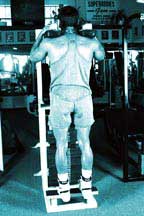

|
Standing or Seated Calf Machine
This exercise can be done from a seated
or standing position. Most gyms have both of these machines. You can
really bum the calve muscles when you concentrate on using your full
range of motion. Start with your heels as low as possible, then extend
upward till you are on your tiptoes.
* Muscle Confusion Tips: Alter the
position of your toes with each workout. Point them outward one workout
to hit the inner calve area, then inward on the next workout to hit the
outer calve area. If you train with your toes outward on this exercise
then make sure to do the opposite on the seated calve machine.
|
|

Sets and
Reps
Depending on how close he is to showtime, Don will alter his set and rep scheme in familiar pro
preparation,
lowering weight and adding reps as the contest nears. If you're hoping to add
mass, up the weight until you have sets of between 6 to 10 reps. You can keep
the weight the same for successive sets, which will lower the reps in each set,
due to muscular fatigue. Or, you can keep the reps relatively constant by
lowering the weight with each successive set. Pyramiding is also popular: Add
weight after each set and your reps are definitely going to go down. Be careful:
It is especially important to use only the weight you can fully control in
performing these movements. Form definitely counts when your back and discs are
involved. Make sure to warm up slowly and with very low weights before making
any push.
|

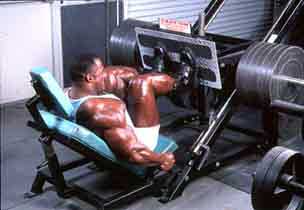 |
Don Long begins with leg
presses,
somewhat more gentle on the back than squats. If you have difficulty with squats
or experience recurring back problems, leg presses are a good alternative. Most
bodybuilders will alternate leg presses with squats over a long period, however,
reaffirming the adage that muscular growth is prompted by changing up the
workout routine, preventing over-adapting to a particular movement.
Beginning
Position
After
determining an appropriate beginning weight, seat yourself in the leg press
machine, making good firm contact between the length of your back and the
support. Your lower back should be in contact with the "backboard," rather than
placed partially on the seat. Be aware of your foot position: For the leg press
and any form of squats, altering leg position and orientation of the toes
changes the targeted areas. Generally, feet should be shoulder width apart with
the toes pointed slightly outward (about 5 to 8 degrees). To emphasize the inner
thigh, put the feet closer together and/or point the toes straight ahead. For
inner thigh emphasis, place the feet slightly wider than shoulder width apart
and angle the toes outward.
The
Exercise
Release
the safety levers and allow the weight to come to your chest in a smooth and
controlled flow. If you cannot control the weight, you're using too much. Allow
your knees to bend fully, bringing them to your chest. Then push the weights
away from you by extending your legs in a controlled manner. You'll want to
fully extend your legs...almost. If your knees "lock out" then you've relieved
pressure on the thighs and transferred the tension to the knee joint; in effect,
you're resting. Instead, extend your knees until they almost lock out. You can
vary the tempo of each part of this movement, but most bodybuilders will take 2
to 3 seconds to allow their knees to touch their chest; pause for a second; push
the weight away in a second; and pause again for a second as their knees are
almost fully extended.
|
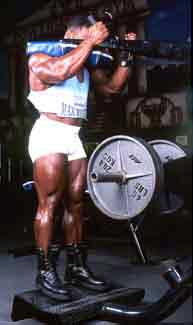

|
The standing machine power squatlooks
like a hack squat done in a standing position. It's an interesting variation
that also works the thighs. This variation works the muscles at a slightly
different angle and is especially useful for the advanced bodybuilder who needs
to vary his or her routine.
Beginning
Position
Don stands on the base of the machine
and lets his arms rest outside the pads. He adjusts his position so that the
shoulder pads fit comfortably over his traps. Once he is positioned correctly he
stands up and releases the lock that keeps the pads up, allowing them and the
weights to come down.
The
Exercise
Control the weight as your knees bend
to a "parallel" position. Most people prefer a 2 to 3-second period to complete
this, although advanced bodybuilders will alter this tempo. (Note that the base
of this particular machine is angled up slightly. This means that you will not
actually go "parallel" , but your thigh and lower leg will form a 90-degree
angle, regardless of incline or decline.) Do not go deeper than 90 degrees
unless you have expert personal instruction and need the extended range of
motion for a particular sports application or rehabilitation. Going deeper than
parallel, you can place enormous pressure on the ligaments and tendons
surrounding the knee.
Hold the weight in position for a
second, and return to a fully erect position. Maintain the weight there for a
second and repeat the motion. As indicated in the leg press sequence, you'll get
more work to the muscle if you do not lock out when fully standing, bringing the
knee to an almost locked out position. Look around your gym, however, and you'll
see experienced bodybuilders who do lock out. Why? Hopefully, they're performing
a variation to prevent too much adaptation to the exercise.
Take care in performing this and all
other squat-type exercises. Keep your eyes and head aimed relatively
straightforward and be acutely aware of any spinal movement. Your legs should be
doing the work, rather than changing the bow of the back. Be very careful about
spinal bowing; your back should remain virtually straight. Although a slight
bowing is okay, make certain that your back does not flex or contract
unnecessarily. This applies to both views; as seen from the side and as seen
from the front of back. Watch yourself in the mirror, if possible. And always
watch yourself when doing squats: Do not allow one side to come up more quickly
than the other, producing a side-to-side bowing of the back. The purpose of this
exercise is to isolate the leg, rather than draw in adjacent muscle
groups.
|

 |
Leg extensions
are commonly thought to
add shape and definition to the front of the thigh, but they can also be used as
mass builders by increasing weight and concurrently lowering the reps. Many gyms
have newer leg extension machines in which the weight stack is attached to a
cambered "Nautilus" sprocket. This increases the effective load as you extend
your leg, keeping the effort needed at a peak. Either machine will work well,
however. If your gym has both, a periodic changeup helps muscle
confusion.
Beginning Position
Seat yourself in the leg extension machine. Allow your knees
to move fully over the edge of the bench, and hold the bench or grips on its
side for balance and stability. Place your feet under the padded bar (on some
older machines the bar rests on your lower shins; on some newer ones, there's a
fully rotating pad).
The
Exercise
Most experts suggest extending your
legs until they almost lock out. When using heavy weight, there's a tendency to
extend...but not quite enough. Check your extension without any weight versus
your extension with the machine loaded. If they're not at the same fully
extended level, you're probably using too much weight. If you have a training
partner you can have him or her hold their hand at the appropriate level to
ensure you perform at your max. Again, press the weight away from you in about
one second, pause at the extension for a second and return the weight in a
controlled manner, taking 2 to 3 seconds. Pause for a second and begin again.
Variation
Note the one-legged variation which
isolates each leg, ensuring that an even load is carried by each side of the
body.
To isolate each leg biceps, Don often
uses this variation of the leg curl. It enables him to isolate each leg
biceps.
|
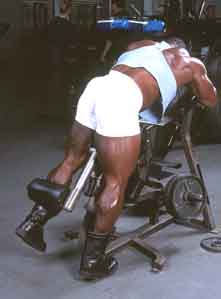
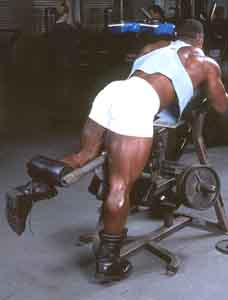
|
Most
standing leg curl machines mandate by their design that you stand with one leg
on the floor. In this series, Don is using a machine that's angled at 45 degrees
from the floor. Place one leg behind the padded bar. Curl the weight up in a
steady controlled manner, taking care not to shift your body...it's the leg
biceps which needs to do the work, not the back. Sustain the contraction for a
second or so, allow the weight to return in 2 to 3 seconds. Pause and begin
again. Make sure to alternate legs. |
The Quads
are the front part of the thighs, and as the name implies, consists of 4
muscles. The knee joints pretty much only let your leg flex in one plane of
motion, making it rather difficult to target individual muscles of the quads.
Some say different foot positioning during the squat targets different areas of
the quad. Though I don't know for sure if this is true or not, I do know that if
you do the squat, or most any quad exercise, you don't have to worry about
underdevelopment of any one muscle in your thighs.
When I first started
doing heavy squats I noticed a tightness/soreness/pulling at the very top of my
thigh, near the groin. I talked to a trainer about it, and he told me I've got a
muscle imbalance, and that I would have train my adductors more. So if you
experience the same thing, try this exercise: Sit on the end of a bench holding
onto the sides, your legs straight. Then pull your knees up towards your chest,
bending your legs. Most of the time you see this as an abdominal exercise, but I
think that is a bit of a misconception, kinda like people doing old-fashioned
sit-ups for abs. Do a couple of sets, and you'll see where you get sore! Vary
how much you bend your knees to get the most out of this exercise.
|
 |
Squats
This is by far the single best exercise you can do
for your body. It uses probably about 60% of all your muscles, gets your
heart pounding, is said to expand your chest, and is said to cause an
increase of testosterone in your blood. That said, it is also the most
difficult exercise to master, and master it you must. Proper form is of
utmost importance. If you can't use proper form, practice with light
weight and stretch your hips, legs, and groin till you can (not
necessarily all in one day!).
- Do several warm-up sets, with some stretching to prepare for heavier sets.
Stretching allows you to use better form, and makes it easier to go further
down in the squat.
- Take longer rests between sets than with other
exercises. Catch your breath. Rests can last up to 5 minutes.
- Use a foot stance that allows you to go down as far as possible.
Preferably close to shoulder width apart (maybe more), toes pointed out no
more than 30 degrees.
- Never let your back round out, keep it slightly
arched.
- Never let your hip move out of the center line of motion. Use a mirror to
check your form. Keep your hips under the bar, not swing out back excessively.
- Never let the bar move ahead of your feet.
- Keep your eyes level - don't look down, and don't look up
- Don't lock out your knees at the top of the motion.
- Go Down until your thigh is roughly parallel with the
floor.
- Don't use belt's and knee wraps unless using a lot of
weight. If you use
them early on, your muscles won't develop to support you, and you risk injury
when you do go to heavy weights.
- Don't come up so fast as to cause the bar to
bounce. Not only can this
lead to injury and instability, it would indicate that you are lifting way to
fast! Slow down and get the most out of each set.
For more
information, visit Dr. Squats web
site. For his page on squatting specifically, go here!. There you'll find discussion of
myths, advantages, different variations, and various techniques.
Other
exercises include: leg extensions, hack squats, and leg press are some of the
more popular exercises, but believe me, they just don't compare to the squat.
Perhaps a little later on I will cover some of these exercises, but for now, I'll leave it at
that.
|
 |
Lunges
Kind of like a one-legged squat, this is a good
exercise to alternate with squats for some variety. Someone asked me if
this would be a good exercise for the glutes, and I looked for an answer,
but couldn't find one. My guess would be yes, since it's kind of like
doing stairs, which is great for the butt. Probably an even better way to
target the glutes would be to do 'step ups' onto a bench. But balancing
could be difficult.
- Place a barbell on your shoulders, or hold it between your legs, or hold
onto two dumbbells at your side.
- Do only one leg at a time! Watching people constantly switching legs makes
me whince, they throw themselves off balance every rep, their foot position is
inconsistent, it's just plain ugly, and I can see no benefit.
- When in the lunge position, your knee should not be in front of your toe
(this is why inconsistent foot position in alternating lunges is bad).
- Bend your forward knee until your back knee just touches the
ground, and
lift.
I've never really been a big fan of
lunges, probably cause my
knees have a tendency to tweak pretty easily. Mind you, it might help in
strengthening the knees if done with lighter weights. Lunges will take a bit of
getting used to because of the balance needed, but do have many benefits to make
them worth your while.
|
| |
Hack SquatsI basically never do this
exercise. Maybe if you have back problems, this exercise would be good for you,
but otherwise, I wouldn't recommend it for the same reason as a smith squat
machine. You don't need any balance and it puts extra strain on your knees,
which is very bad. Think about it, doing a hack squat is the same as regular
squat except for one aspect: its easier! If you want it easier, you're wasting
your time.
|
| |
Leg ExtensionsThese are fun from time to
time, but should definitely not be your only exercise. Perhaps as a finishing
exercise cause it gives a pretty good stretch, and a really good burn. Not much
to say about how to do it, just do it sparingly, and save your energy for real
exercises. Think of this exercise as a triceps kick-back. You don't do those for
mass, do you?
|
| |
Leg PressThese could be beneficial in
building some power in your legs. You can do a lot of weight fairly safely, and
it's still a pressing motion. In following the triceps analogy, the could almost
be compared to close grip bench. Though no replacement for squats, they can add
some beneficial spice to your leg routine.
|
Sample Leg RoutineMy leg days are usually
pretty simple: Squats, leg curls(or stiff-leg deadlifts), standing & seated
calf raises. The truth is, I haven't been working legs consistently for all that
long, so I can get away with doing such a simple workout and still make some
pretty decent gains. I think great gains could be made with such a simple
routine for most people, as long as you vary your sets, reps, and lifting
speeds.
For quads alone, I would do something like 6 sets, with reps of
10, 10, 8, 8, 6, 6. Or something like that. Sometimes I'll just to 6 sets of 4-6
reps, or 4 sets of ~15 reps. What ever I feel like. Definitely start your
workout with squats, since they require the most energy and focus. Then move to
leg press for a few heavy sets, warm-up should be unnecessary, and perhaps
finish with a set or two of leg extensions.
Try this on heavier leg days:
- cycle for 5 minutes to warm up
- 3-4 consecutive warm-up sets, increasing the weight every
time, reps of ~
8,6,4,2
- 3-4 working sets of squats, reps of ~10,8,6
- 2-3 working sets of leg press, reps of ~8,6
- 1-2 working sets of leg extensions, reps of ~10
Try this on
lighter leg days:
- cycle for 5 minutes to warm up
- 3-4 consecutive warm-up sets, increasing the weight every
time, reps of ~
8,6,4,2
- 2-3 working sets of squats, reps of ~15,12,10
- 2 working sets of leg press, reps of ~12,10
- 1 working sets of leg extensions, reps of ~15
With such a large
muscle, you need a long rest between sets, so I prefer to superset quad
exercises with hamstrings. It's simple, on heavy days do a set for quads, rest 2
minutes, do a set for hams, rest 2 minutes, start over. This gives your muscles
5 minutes between sets, plenty of time to recuperate for another heavy set! On
light days, rest only 1 minute between exercises.
|
|
This is the
biceps of the leg, located on the back part of your leg. This is another often
neglected and/or under-trained body part. Most common exercise is leg curls,
where you lie on your stomach, and lift the weight behind you with your ankles.
This is a great exercise for starting out, but if you want to hit them as hard
as you can, then try this exercise!
|
 |
Straight leg deadlifts
This is a bizarre exercise! You could have been doing
leg curls for a while already, but this one'll still get you sore, so
start easy. It may not feel like it does a lot, and you may be tempted to
throw on more weight, but trust me, do only light sets for the first week
or two.
- Warm up a lot for this exercise, since ham strings are very easy to pull.
Start off with very light weights.
- Do some stretching between sets, being careful not to pull
anything.
- Feet should be close together, at most shoulder width
apart.
- Start standing straight, keep your legs straight ( but still slightly
bent! ), holding on to the bar either palms facing your legs, or powerlifting
grip (one palm in, the other out).
- Let your butt move back as you bend at the hips to lower the
weight. Keep
you back neutral (straight). Do not let your back round out!
- I have heard various arguments as to how far to lower the
weight. Some say
about 45 degrees is plenty, any further and you just work your lower back.
Others say go all the way down. I think it is important to focus on just
moving at the hips so that only the hams are doing the work. Just like your
wrists shouldn't bend when you are doing curls.
- My most reliable source so far recommends not bending past 30-35
degrees,
going any lower puts too much strain on the lower back, and...
- When straightening out, do not hyperextend, or over-straighten your back.
Just straighten out to a point where it is comfortable.
|
| |
This is probably a better
exercise to start with since it lets you warm up your hamstrings. Straight
legged deadlifts can be quite deceiving in that they don't really feel like
they're doing to much, and it is easy to strain your muscle in a bad way without
sufficient warm-up. Pretty much every gym has this machine, and it comes in two
variations: flat and with a hump. The purpose of the hump is to eliminate your
hip flexors from becoming involved. Recently in Muscle Media I have read that
the bench with the hump is better, but I have also read the opposite. Everyone
has a different theory! The advice that holds true for any machine is to keep
your hips planted on the bench, and use only your leg biceps (hamstrings) to
move the weight.
Since this muscle is often neglected, I would recommend
going fairly light the first few workouts, but since the hamstring is primarily
a fast twitch fiber, you will want to move towards lower reps with more weight
for maximal development. Using different foot spacing on the pads may also help
target different heads of your leg biceps, much like arm biceps exercises do.
|
Sample routine for HamstringsAs I said
earlier, I prefer to superset hamstrings with quads. Here I will just the
hamstring workout.
- cycling 5 minutes to warm up
- 3 consecutive sets of leg curls for warm up, increasing weight, decreasing
reps (8,6,4), followed by 3 minute rest
- 3 working sets of leg curls, reps of 6-8
- 1-2 warm up sets of stiff-leg deadlifts (just in case!)
- 3 working sets of stiff-leg deadlifts, reps of 4-8
For lighter
days, lessen weight, increase reps, decrease rest time. Refer to quad sample
routine for more details.
|
|
Calves
are often argued to be the most difficult muscle to develop, probably cause we
use it every day the instant we stand up. It's used to being worked lots, and so
doesn't respond much to training. Recently a training article in Muscle Media
pointed out that the trick is in stressing the calves in different ways, from
different angles. For instance, holding a dumbell in one hand, and balancing
yourself with the other hand, do one legged calf raises on a block, and move the
dumbell in front of you, behind you, and change hands for the same calf. I
believe the calves can be coaxed into growth with lower reps/higher weight like
most muscles. You just gotta really push them, with nice slow, deliberate
movements.
|
| |
Seated calf raisesBeing done on a
machine, there isn't that much to say for this exercise. It works the part of
the calf that lies closer to the bone, so it won't give you that wicked,
upside-down heart shaped calf. But it will add mass, and make your calf a lot
thicker. Pack on the weight, do slow, full reps. Let your heel go down as
far as possible, and push your heel all the way up, until your almost on you
tipee-toes. This exercise works mostly the soleus, the muscle closer to your
bone, and being mostly slow-twitch muscle, you should use a higher rep range,
i.e. ~15 reps
|
 |
Standing calf raises
These can be done as described in the intro to calves
by holding a dumbell in one hand and balancing yourself with the other. Or
if you prefer, on hack squat machines, or other calf raise machines that
may be available. Standing on a block do a full reps, contracting hard at
the top, and stretching all the way at the bottom. This can also be done
with a calf raise machine that you stand under, or donkey raises. This is
the exercise you'll want to do if your looking for a good shape in your
calf by working the gastrocnemius, which is primarily a slow twitch fiber,
and requires lower reps, less than 10. |
Sample calf routineI'll usually finish my
leg day with these, or maybe tack them onto another day. Since, by the end of a
workout I'm looking to get out of the gym and pursue any semblance of a life, my
calf workouts are usually sorely lacking. To hurry things along, I like to
super-set the two heads of the calf muscle as well, alternating seated and
standing calf raises.
- 1-2 warm-up sets of each exercise
- 2-3 working sets of each exercise, 6-8 reps for standing, 10-15 reps for
seated.
- always be sure to use full range of motion, and fully stretch the calf at
the bottom position of each rep.
|
Glutes
get a lot of work from most compound exercises that are used to develop quads
such as the squat and leg press. Also, using stiff-legged deadlifts also
involves the glutes to a certain extent. To use the glutes more durind
stiff-legged deadlifts, lower your body as low as possible, without losing the
neutral position of your spine, i.e. don't round your back!!
If you want
more glute work, lunges work well, or even better, stepping up onto a raised
block. Much like lunges, put a barbell on your shoulders, or hold onto two
dumbbells at your sides. Then, stand in front of a box/step (anywhere from a few
inches to 2 feet high), step onto the box one foot at a time, and lift your wait
up. Then switch feet. This requires a fair bit of balance, so practice with very
light weight.
|
|


 In the
opinion of most bodybuilders,
In the
opinion of most bodybuilders, 
 One good
thing about hack squats is that it is almost impossible to be out of form. If
you are uncomfortable with doing heavy weights with the basic squat, try it with
the
One good
thing about hack squats is that it is almost impossible to be out of form. If
you are uncomfortable with doing heavy weights with the basic squat, try it with
the  The leg extension can be used as a
warmup exercise or as another mass building exercise. Personally, I like to use
the leg extension as one of the final exercises (along with the leg curls) to
end my leg routine. Try to do 4 sets of these with the first two being heavy
sets (able to do up to 8 reps). Let the final 2 be your cool down sets. Try to
do a higher number of reps (10 to 12 reps). This provides for a good cool down
plus a period to work on definition. If you feel that you have exhausted the
quads before getting to this exercise, try doing all light weight sets to
work on definition. This also applies to the leg curls. Always remember that the
main thing you want to focus on is your form. You want to have a controlled
motion when lifting the weights and a resistence to them when lowering . If you
find yourself lacking control, decrease weight accordingly.
The leg extension can be used as a
warmup exercise or as another mass building exercise. Personally, I like to use
the leg extension as one of the final exercises (along with the leg curls) to
end my leg routine. Try to do 4 sets of these with the first two being heavy
sets (able to do up to 8 reps). Let the final 2 be your cool down sets. Try to
do a higher number of reps (10 to 12 reps). This provides for a good cool down
plus a period to work on definition. If you feel that you have exhausted the
quads before getting to this exercise, try doing all light weight sets to
work on definition. This also applies to the leg curls. Always remember that the
main thing you want to focus on is your form. You want to have a controlled
motion when lifting the weights and a resistence to them when lowering . If you
find yourself lacking control, decrease weight accordingly.
 The
leg curl
is the reverse of the leg extension, While lying on the machine on your stomach,
lift the weights of the machine towards the rear end. This machine is used to
work the hamstrings. Doing extremely heavy weights with this machine can help
build the mass of the hamstrings but it is basically used for toning. This
machine can be used for a little of both. Try doing the first couple of sets
using heavier weight. Use weight heavy enough to get up to 6 reps. For the final
2 sets, try lowering the weight to maximize toning. Try to push out 10 to 12
reps. You may want to alter the weights and rep ratio for your personal needs.
If you want to focus more on definition, keep using lighter weights with more
reps. If your looking for mass, try heavier weights with less reps. But it is
best to do a little of both for better overall development.
The
leg curl
is the reverse of the leg extension, While lying on the machine on your stomach,
lift the weights of the machine towards the rear end. This machine is used to
work the hamstrings. Doing extremely heavy weights with this machine can help
build the mass of the hamstrings but it is basically used for toning. This
machine can be used for a little of both. Try doing the first couple of sets
using heavier weight. Use weight heavy enough to get up to 6 reps. For the final
2 sets, try lowering the weight to maximize toning. Try to push out 10 to 12
reps. You may want to alter the weights and rep ratio for your personal needs.
If you want to focus more on definition, keep using lighter weights with more
reps. If your looking for mass, try heavier weights with less reps. But it is
best to do a little of both for better overall development.




























